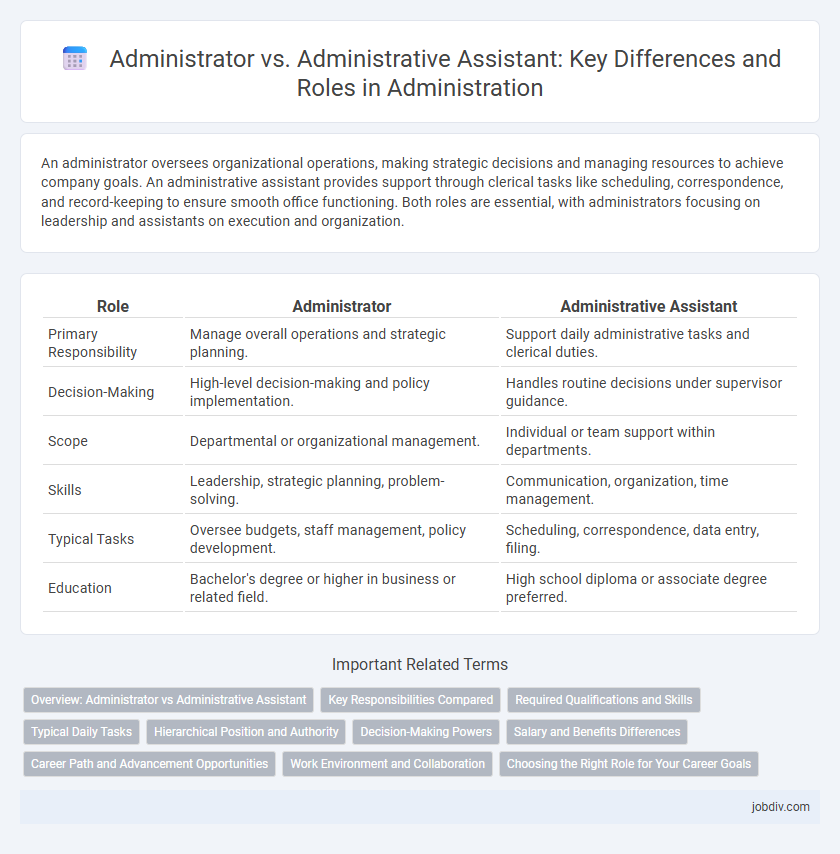An administrator oversees organizational operations, making strategic decisions and managing resources to achieve company goals. An administrative assistant provides support through clerical tasks like scheduling, correspondence, and record-keeping to ensure smooth office functioning. Both roles are essential, with administrators focusing on leadership and assistants on execution and organization.
Table of Comparison
| Role | Administrator | Administrative Assistant |
|---|---|---|
| Primary Responsibility | Manage overall operations and strategic planning. | Support daily administrative tasks and clerical duties. |
| Decision-Making | High-level decision-making and policy implementation. | Handles routine decisions under supervisor guidance. |
| Scope | Departmental or organizational management. | Individual or team support within departments. |
| Skills | Leadership, strategic planning, problem-solving. | Communication, organization, time management. |
| Typical Tasks | Oversee budgets, staff management, policy development. | Scheduling, correspondence, data entry, filing. |
| Education | Bachelor's degree or higher in business or related field. | High school diploma or associate degree preferred. |
Overview: Administrator vs Administrative Assistant
An Administrator typically oversees organizational operations, managing teams, resources, and strategic planning to ensure efficiency and goal achievement. An Administrative Assistant primarily supports this process by handling clerical duties such as scheduling, correspondence, and office management to maintain smooth day-to-day functions. The key difference lies in the Administrator's leadership role versus the Administrative Assistant's supportive responsibilities within the administrative framework.
Key Responsibilities Compared
Administrators oversee organizational operations, making strategic decisions, managing budgets, and coordinating departments to ensure efficient workflow. Administrative Assistants provide essential support by handling scheduling, correspondence, and record-keeping, enabling smooth daily administrative functions. Their distinct roles contribute to overall organizational effectiveness through leadership and operational assistance.
Required Qualifications and Skills
Administrators typically require a bachelor's degree in business administration or a related field, accompanied by strong leadership, project management, and strategic planning skills essential for overseeing organizational operations. Administrative Assistants generally need a high school diploma or associate degree with proficiency in office software, communication, and time management to efficiently support executives and manage clerical tasks. Both roles demand excellent organizational abilities, attention to detail, and interpersonal skills to ensure smooth workflow and effective team collaboration.
Typical Daily Tasks
Administrators often oversee office operations, manage staff schedules, and handle budgeting responsibilities to ensure efficient organizational workflow. Administrative Assistants focus on supporting executives by managing correspondence, organizing meetings, and maintaining records. Both roles require strong communication skills, but Administrators typically engage in higher-level decision-making and strategic planning.
Hierarchical Position and Authority
Administrators typically hold higher hierarchical positions with decision-making authority and oversight responsibilities within an organization. Administrative Assistants support administrators by managing schedules, handling correspondence, and performing clerical tasks without possessing significant decision-making power. The authority gap is reflected in their roles, with administrators setting policies and directives while assistants facilitate daily operational efficiency.
Decision-Making Powers
Administrators possess significant decision-making powers, overseeing strategic planning, budget allocation, and policy implementation within organizations. Administrative Assistants primarily support these processes by managing schedules, coordinating communication, and preparing reports, without authority to make executive decisions. The distinction lies in the administrator's role in shaping organizational direction versus the assistant's focus on facilitating operational efficiency.
Salary and Benefits Differences
Administrators typically earn higher salaries than Administrative Assistants, with median annual pay ranging from $60,000 to $80,000 compared to $35,000 to $50,000 for assistants, reflecting their greater responsibilities and decision-making roles. Benefit packages for Administrators often include comprehensive health insurance, retirement plans, performance bonuses, and paid leave, whereas Administrative Assistants usually receive basic benefits such as standard health coverage and limited paid time off. The salary and benefits disparity aligns with the complexity and scope of tasks managed by Administrators versus the more supportive, clerical duties handled by Administrative Assistants.
Career Path and Advancement Opportunities
Administrators typically hold higher-level roles involving strategic decision-making, management of departments, and oversight of organizational operations, offering a clearer path to executive positions such as Office Manager or Director of Administration. Administrative Assistants support these functions by handling clerical tasks, scheduling, and communication, serving as an entry point with potential advancement into roles like Executive Assistant or Office Coordinator. Career progression for administrators often requires advanced education and leadership experience, while administrative assistants can advance through skill development and increased responsibility within the administrative support field.
Work Environment and Collaboration
Administrators typically work in managerial or executive environments where they oversee operations, make strategic decisions, and lead teams across various departments. Administrative Assistants operate in more supportive roles within offices, facilitating communication, organizing schedules, and managing day-to-day tasks to enhance efficiency. Collaboration for Administrators often involves cross-departmental leadership and stakeholder engagement, while Administrative Assistants coordinate closely with their supervisors and colleagues to ensure smooth administrative workflows.
Choosing the Right Role for Your Career Goals
Choosing between an Administrator and an Administrative Assistant role depends on your long-term career goals and desired responsibilities. Administrators typically handle higher-level tasks such as managing operations, overseeing staff, and strategic planning, which suits those aiming for leadership positions. Administrative Assistants focus on supporting executives, scheduling, and clerical duties, ideal for individuals seeking entry-level roles or skill-building in office management.
Administrator vs Administrative Assistant Infographic

 jobdiv.com
jobdiv.com